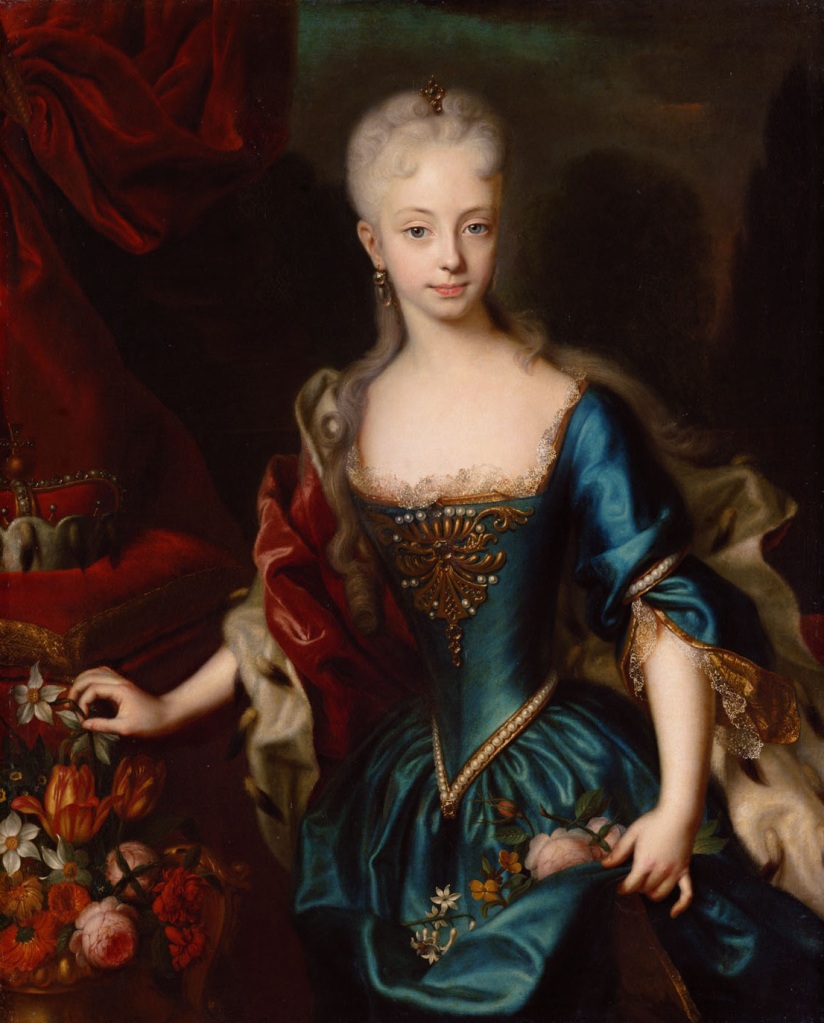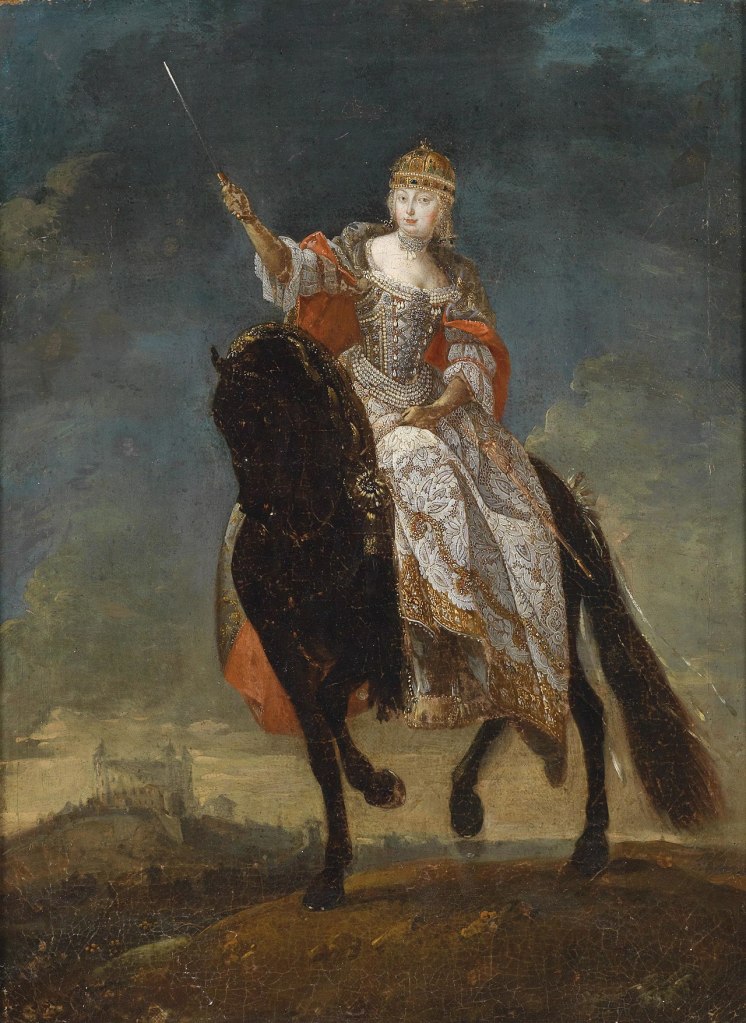
Listen here: https://anchor.fm/cj123/episodes/18th-Century-Podcast-Episode-16-Archduchess-Maria-Theresa-e5ffcq/a-ao7vas
Summary
In this episode, we will be taking a look at the life of Archduchess Maria Theresa. She was involved in one of the key conflicts of the 18th Century, The War Of Austrian Succession.
Script
INTRO
Welcome back to the 18th Century Podcast. I am your host, Cj. In today’s episode, we will be taking a look at the life of Archduchess Maria Theresa. She was involved in one of the key conflicts of the 18th Century, The War Of Austrian Succession. If you’d like to read the script for this episode and its citations, go to 18thcentury.home.blog that’s 1, 8, t h, century dot home dot blog. Type the numbers don’t spell them. Let’s begin this episode by taking a look at her early life before she gained the crown.
PART 1 EARLY LIFE

Archduchess Maria Theresa was born on May 13th, 1717, in Vienna. She was the eldest daughter of the Holy Roman Emperor, Charles VI of the Habsburg dynasty and Elisabeth Christine of Brunswick-Wolfenbüttel. I have to provide a little context a few years before her birth. Under the law of the time, only male heirs could assume the throne. Charles was concerned he wouldn’t have a male heir. So in 1713, he issued the Pragmatic Sanction, which would allow his eldest daughter to assume the throne if he could not provide a male heir. He would produce a male heir but tragically the heir would die an infant in 1716. When the Pragmatic Sanction was issued most of the Monarchs under Charles accepted it. Maria’s education was typical for that of a noblewoman during the time. However, she was not taught about the matters of Statecraft. In 1736 Maria would marry. The circumstances around her marriage are a bit unusual for the time. Charles VI advisor, Prince Eugene of Savoy, recommended that he should have his daughter married off to someone who held great power. This would be the conventional wisdom of the time. Instead, Charles chose to let his daughter marry someone she loved. Maria had fallen for a French Duke, by the name of Francis Stephen of Lorraine. They would marry in 1736. For the French, this was a problem. If one of their Dukes married into the Hapsburg line, the Hapsburg would have a claim over French territory. To appease the French Monarchy, Duke Francis traded his territory for the province of Tuscany. At this time, Tuscany was considered to be of lesser value. What is truly remarkable is how many children the new royal couple would produce throughout their lives. Maria would give birth to sixteen children, ten of them would survive to adulthood. They had 5 sons and 11 daughters, and one of those daughters was, Marie Antoinette. Then in 1740, Charles VI would die, and the crown would pass to Maria. The War Of Austrian Succession was about to begin.
PART 2 TAKING THE CROWN & THE WAR OF AUSTRIAN SUCCESSION

On October 20th, 1740, Charles VI died. At the age of 23, Maria Theresa would ascend the throne, becoming the Empress of the Holy Roman Empire, and Archduchess of Austria. What she inherited was a terrible situation. She had no training in running the government, the treasury was practically empty, their army was weak, and the Capitol was seated with unrest. But to her benefit, the duchies of Austria, Bohemia, Netherlands, and Hungary accepted her as their Empress. One of the first major challenges Maria faced was when Frederick the Great invaded Silesia by December. Then the French and Bavarians invaded her to the West. Her main focus for most of the war would be on the Prussians as they were the greater threat, but she could not ignore being invaded from 2 fronts. France, Bavaria, Saxony, and Spain supported a challenger to Maria’s Thorne, Charles Albert, Elector of Bavaria. Frederick the Great overtook Silesia in April of 1741. Maria’s main supporter in the war was the British. Though she had initial failures, there were some successes to come, even though Frederick would hold onto Silesia. During July of 1742, She drove off the French and Bavarians from Bohemia. She went right into the Bavarian territory. Her allies would defeat the French in 1743 at the Battle of Dettingen, in Bavaria. In September of the same year, Savoy would join Maria’s side along with the British, Hanoverians, and Hessians. The French would withdraw to their borders. Fortune would go more in Maria’s favor in January of 1745, when her Bavarian challenger, Charles Albert died. Albert’s son had little interest in continuing the conflict. He would give his support to Maria’s husband if Bavarian lands were returned. This would be made official in December, the Treaty of Dresden was signed. The Imperial Crown would pass to her husband, as the law prevented women from taking it. Though this wouldn’t be the complete end of the war. Fighting between her other foes continued until 1748. In October of 1748, the Treaty of Aix-la-Chapelle was signed. This treaty granted Prussia the right to keep Silesia. It had Maria cede three territories to the second son of the King of Spain but in exchange for her Netherlands territory which was begin held by France. It wasn’t the best situation for Maria by the end of the war, and it didn’t help that she never got a General up to the job. It wasn’t her proudest moment, but the War was over. Now, we’re going to take a short break, and when we come back, we’ll take a look at Maria’s domestic policy, and her later life. We’ll be right back.
PART 3 DOMESTIC POLICY AND LATER LIFE

Welcome back. Maria’s domestic policy was good and bad in some respects. Because of the War, she would increase her army’s size by about 200% and she also increased taxes. She combined the Austrian and Bohemian chancelleries. Maria would also go on to create a Supreme Court to uphold justice within her territory. Maria was also a devote Catholic, and she had a distasteful view of Protestants. In 1741 she kicked Jews out of Prague. She was very conservative in her religious views. Two academies would be established under her rule. The first being the Theresian Military Academy in 1752, and in 1754 she established an academy for engineering and science. She would also increase funding to the University of Vienna for medical research. She spent years fortifying her army and was preparing an attack on Prussia in 1756. What she didn’t expect was for Prussia to attack first. Frederick the Great would invade Saxony and this first move began the Seven Years War. The war would conclude in 1763 when Maria signed a treaty, the Treaty of Hubertusburg, recognizing Prussia’s control over most of Silesia. Tragedy would strike in 1765 when her husband perished. She truly loved her husband and grieved over his death for a prolonged period. Upon his death, she appointed her eldest son, Joseph II, as coregent and as Emperor. They didn’t see eye to eye having conflicting views on running the State. She viewed her son’s youth and inexperience as being rash. Joseph II flirted with enlightenment ideas which were more in accordance with her rival, Frederick the Great. She would have his powers limited for the time being. After the death of her husband, she would implement a new penal code to substitute local laws and make the law more standardized across the State. She wanted to centralize control more than she already had, even from the Church even though she was devout in her belief. The Church would become less involved in Secular matters. She would implement censorship among the populace, and lay the groundwork for compulsory education for primary students. Though she continually disagreed with her son, she did allow him to make reforms in the army. In 1767, the Archduchess became infected with Smallpox. Smallpox had been making the rounds around the royal family in the 1760s. Maria was nearly on death’s door. She was given her last rites, but then, recovered. After her recovery, she became a vapid supporter of inoculation. She would set an example for her subjects by making her children get inoculated. In her later years, she focused more so on reforming the law. For example, in 1771 Joseph II and herself issued the Robot Patent, which created regulation for the pay of serfs. She would also go on to abolish witch-burning, torture, and the death penalty. Though it should be noted that the death penalty was later reinstated. In 1772 she spoke out against the first partition of Poland, viewing it as immoral. In 1774 her plans for compulsory education came into fruition. She had a strict policy around decency. She set up a police force designed to enforce her decency policy. This police force was mainly centered in Vienna, and one class of people they would arrest were prostitutes. These women would be sent off to the small eastern villages. Some writers of the time noted, quote, “exceptionally beautiful women” unquote, lived in these tiny villages. Maria would physically become plumper as she grew older. Her health would waver and in 1780, Archduchess Maria Theresa would meet her end in Vienna. In the 650 year rule of the Hapsburg dynasty, she was the only woman who ruled.
OUTRO
Archduchess Maria Theresa was an interesting historical figure to research. What I learned about her, is not exactly what I expected to find. I hope you enjoyed this episode. The script and citations for this episode and all other episodes can be found at https://18thcentury.home.blog that’s 1, 8, t h, century dot home dot blog. Type the numbers don’t spell them. If you’d like to support the show, please share it and leave a review. I’ve been your host Cj, and thank you for listening to this episode of the 18th Century Podcast.
CITATIONS
“Maria Theresa of Austria.” Maria Theresa of Austria – New World Encyclopedia, 14 Aug. 2018, https://www.newworldencyclopedia.org/entry/Maria_Theresa_of_Austria.
Pick, Robert. “Maria Theresa.” Encyclopædia Britannica, Encyclopædia Britannica, Inc., 14 Aug. 2019, https://www.britannica.com/biography/Maria-Theresa.
“Maria Theresa.” Biography.com, A&E Networks Television, 15 Apr. 2019, https://www.biography.com/activist/maria-theresa.
Britannica, The Editors of Encyclopaedia. “War of the Austrian Succession.” Encyclopædia Britannica, Encyclopædia Britannica, Inc., 9 Dec. 2018, https://www.britannica.com/event/War-of-the-Austrian-Succession.